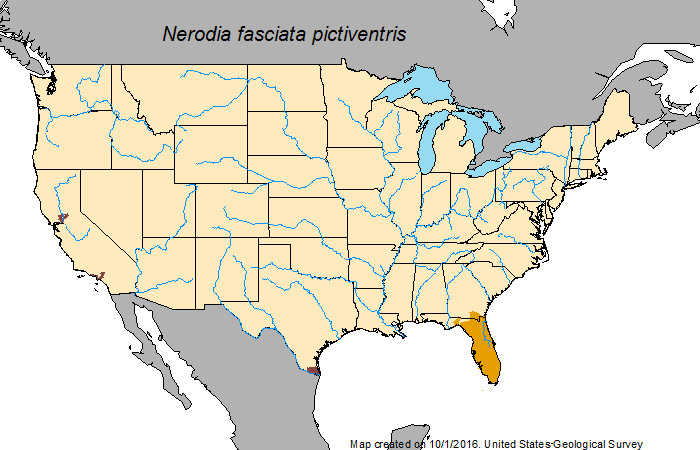Summary
Native Range: Nerodia f. pictiventris is indigenous to peninsular Florida and the extreme corner of southeastern Georgia (Martof, 1956; Stevenson, 1976; Behler and King, 1979; Ashton and Ashton, 1981; Moler, 1988; Carmichael and Williams, 1991; Tennant, 1997, 2003; Conant and Collins, 1998; Ernst and Ernst, 2003; Gibbons and Dorcas, 2004; King, 2006).
Nonindigenous Occurrences: Nonindigenous N. f. pictiventris were probably established in Brownsville, Cameron County, Texas before the 1950s, probably as far back as 1933 (Conant, 1977; Conant and Collins, 1998; Tennant et al., 1998; Dixon, 2000; Tennant and Bartlett, 2000; Werler and Dixon, 2000; Ernst and Ernst, 2003).
A single snake was collected from a pond in west Los Angeles, Los Angeles County, California (Campbell in Bury and Luckenbach, 1976), but it is unclear if it was N. fasciata or Nerodia sipedon (northern watersnake) and the actual locality is in doubt (Balfour et al., 2008a). An established reproducing population lives in Machado Lake in Kenneth Malloy Memorial Park, Harbor City, Los Angeles County, California. In 2005 several specimens were collected and additional individuals and juveniles have been observed at this site (Fuller and Trevett, 2006).
Nonindigenous N. f. pictiventris were discovered in an artificial pond and the adjacent watershed of Sacramento, Sacramento County, California, in 1992, then verified through the collection of more than 30 individuals in June 2000, and augmented by continued observations of other live snakes since this collection (Balfour and Stitt, 2002), including specimens from nearby Folsum, Humbug Creek (Balfour et al., 2008b). These snakes were first identified as N. f. fasciata, but molecular studies conclude the correct subspecies to be N. f. pictiventris (Stitt et al., 2005; Balfour et al., 2008b).
Many specimens were also reported in Lake Natoma, Sacramento, California, in 2001 by the Wildlife Society (Garrison, 2001).
Copyright status:
This image is public domain and was originally posted by the US Geological Survey.
Source:
https://nas.er.usgs.gov/queries/FactSheet.aspx?SpeciesID=1195

